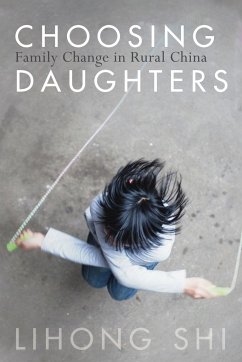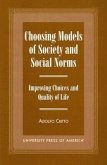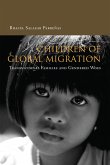- Broschiertes Buch
- Merkliste
- Auf die Merkliste
- Bewerten Bewerten
- Teilen
- Produkt teilen
- Produkterinnerung
- Produkterinnerung
Lihong Shi is Assistant Professor of Anthropology at Case Western Reserve University.
Andere Kunden interessierten sich auch für
![Daughters of the Dreaming Daughters of the Dreaming]() Diane BellDaughters of the Dreaming28,99 €
Diane BellDaughters of the Dreaming28,99 €![Choosing Models of Society and Social Norms Choosing Models of Society and Social Norms]() Adolfo CrittoChoosing Models of Society and Social Norms83,99 €
Adolfo CrittoChoosing Models of Society and Social Norms83,99 €![Sheas Mad Real Sheas Mad Real]() Oneka LabennettSheas Mad Real39,99 €
Oneka LabennettSheas Mad Real39,99 €![Children of Global Migration Children of Global Migration]() Rhacel ParreñasChildren of Global Migration26,99 €
Rhacel ParreñasChildren of Global Migration26,99 €![Household Chores and Household Choices Household Chores and Household Choices]() Household Chores and Household Choices41,99 €
Household Chores and Household Choices41,99 €![Anthropology with an Attitude Anthropology with an Attitude]() Johannes FabianAnthropology with an Attitude37,99 €
Johannes FabianAnthropology with an Attitude37,99 €![How to Make a Wetland How to Make a Wetland]() Caterina ScaramelliHow to Make a Wetland33,99 €
Caterina ScaramelliHow to Make a Wetland33,99 €-
-
-
Lihong Shi is Assistant Professor of Anthropology at Case Western Reserve University.
Hinweis: Dieser Artikel kann nur an eine deutsche Lieferadresse ausgeliefert werden.
Hinweis: Dieser Artikel kann nur an eine deutsche Lieferadresse ausgeliefert werden.
Produktdetails
- Produktdetails
- Verlag: Stanford University Press
- Seitenzahl: 208
- Erscheinungstermin: 18. Juli 2017
- Englisch
- Abmessung: 213mm x 140mm x 15mm
- Gewicht: 295g
- ISBN-13: 9781503602939
- ISBN-10: 1503602931
- Artikelnr.: 47307055
- Herstellerkennzeichnung
- Libri GmbH
- Europaallee 1
- 36244 Bad Hersfeld
- gpsr@libri.de
- Verlag: Stanford University Press
- Seitenzahl: 208
- Erscheinungstermin: 18. Juli 2017
- Englisch
- Abmessung: 213mm x 140mm x 15mm
- Gewicht: 295g
- ISBN-13: 9781503602939
- ISBN-10: 1503602931
- Artikelnr.: 47307055
- Herstellerkennzeichnung
- Libri GmbH
- Europaallee 1
- 36244 Bad Hersfeld
- gpsr@libri.de
Lihong Shi is Assistant Professor of Anthropology at Case Western Reserve University.
Contents and Abstracts
1The Birth-Planning Campaign: Local Experience of Population Control
chapter abstract
Chapter 1 delves into the formulation and implementation of and the
reactions to the birth-planning policy in Lijia Village, focusing on the
birth-planning campaign from the 1970s to 2010, to present a local account
of the practice and the experience of China's population control campaign.
While unfolding the ways in which such a pervasive birth-planning policy
was implemented and received on the local level for more than three
decades, this chapter reveals that as the policy was adjusted and relaxed
and the implementation measures modified, the reactions of the villagers
toward the policy were drastically transformed. More strikingly, with an
increasing number of peasant couples accepting the policy since the 1990s,
a new reproductive pattern of couples willingly embracing a singleton
daughter rather than taking advantage of the relaxed policy that allowed
them to have a second child emerged.
2"Life Is to Enjoy": The Pursuit of the New Ideal of Happiness
chapter abstract
Chapter 2 explores the impact of the pursuit of a new ideal of happiness on
the childbearing preference of young parents. China's burgeoning market
economy and the retreat of the state in governing the social life of
villagers has facilitated the formation of a new ideal of happiness,
defined by material consumption and the enjoyment of leisure. Young
villagers believed that childrearing jeopardized the pursuit of their new
life ideal, which discouraged them from making the decision to have a
second child. In particular, many young women desired to have only one
child to relieve themselves from the burden of childrearing. They were able
to exercise their agency to carry out their reproductive choice for only
one child when their desire did not coincide with the desires of their
husbands.
3One Tiger versus Ten Mice: Raising One Successful Child
chapter abstract
This chapter explores a new childrearing practice and its impact on
childbearing preferences. Young couples had high expectations for their
children's success in adult life and believed that raising one successful
child was more rewarding than raising multiple unsuccessful children. The
increasing cost of a child's daily consumption, driven by rising
consumerism and children's agency in demanding consumption products,
exacerbated the financial burden of childrearing. Moreover, raising a
successful child also required parental support for a child's education,
another major cost of childrearing. Consequently, an increasing number of
young couples decided to concentrate limited family resources on only one
child to secure the best possible upbringing for that child. This new
childrearing belief and practice were not gender specific. Gender-neutral
parental support and close parent-daughter ties further encouraged parents
to stay with a singleton daughter and to support her in an unprecedented
manner.
4"Little Quilted Vest to Warm Parents' Hearts": Gendered Transformation of
Filial Piety
chapter abstract
Chapter 4 examines the gendered transformation of filial piety and its
impact on reproductive choice. It discusses the arrangements of elderly
care and demonstrates that the practice of filial support provided by sons
and daughters-in-law declined. Meanwhile, a married daughter started to
maintain close ties with her parents and proved to be reliable for filial
support. Such a transformation was the result of a reinterpreted
intergenerational exchange, women's emerging practice to their parents, and
the shift of postmarital residence patterns and women's socially
constructed role as being more considerate than men. The decline of sons'
filial support had weakened the desire for a son among young parents. They
had started to make multiple preparations for their old age, including
cultivating a close bond with a daughter.
5"Here Comes My Big Debt": Wedding Costs and Sons as Financial Burdens
chapter abstract
Chapter 5 delves into the escalating burden of financing a son's wedding
and its impact on reproductive choice. While marriage was significant for a
man's having a lifelong companionship and establishing his status in his
community, the patrilineal practice of a groom's family financing a wedding
persisted. In the sex-ratio imbalanced marriage market, young women had
gained leverage in negotiating marriage proposals, exacerbating the burden
of wedding financing. Not only were parents expected to fulfill this
critical parental obligation, they had to continue their support for their
sons and daughters-in-law after their wedding to help maintain their sons'
marriage. Consequently, a son had become a financial burden for his parents
instead of a source of financial support in old age. This drastic shift of
the role of sons further encouraged couples to willingly accept a singleton
daughter.
6Emerging from the Ancestors' Shadow: Weakened Belief in Family Continuity
chapter abstract
Chapter 6 explores the eroding effect that the belief in family continuity
has had on the preference for sons. Without the presence of a lineage
culture, there is no institutional support for the belief and practice of
having a son to pass on the family line. Furthermore, skepticism concerning
the belief in an afterlife and a reciprocal relationship between the
ancestors and the living descendants had shaken the religious and cultural
significance of having a son to perform ancestral rituals. Finally, while
families without a son used to be stigmatized by their communities, such
stigma had been removed as financial capability had become the most
significant marker for social status. In the process of emerging from
ancestors' shadows, young couples who had a singleton daughter no longer
considered family continuity a necessity for their nuclear family and had
willingly embraced a singleton daughter.
Conclusion
chapter abstract
The conclusion discusses the implications of this emerging reproductive
pattern of parents' embracing singleton daughters on the understandings of
family transformations in rural China in general and son preference in
particular. It also discusses the ways in which this reproductive choice
sheds light on the studies on state-society relations in reproductive
choice and control in China.
Introduction
chapter abstract
The introduction first situates this research in the literature on
state-society relations in reproductive choice and control in China, the
reproductive preference for a son among Chinese families, and the media and
scholarly attention on China's "missing girls." It then introduces the
emergence of a new reproductive pattern of rural couples' embracing a
singleton daughter in China's demographic landscape. It discusses the
community (Lijia Village) in which the research was conducted, in
particular, the location, history, demographic makeup, economic activities,
and the practices of marriage and ancestral rituals of the residents. The
chapter also discusses the development of the research project and the
research methodology and concludes with an outline of the remaining
chapters of this book.
1The Birth-Planning Campaign: Local Experience of Population Control
chapter abstract
Chapter 1 delves into the formulation and implementation of and the
reactions to the birth-planning policy in Lijia Village, focusing on the
birth-planning campaign from the 1970s to 2010, to present a local account
of the practice and the experience of China's population control campaign.
While unfolding the ways in which such a pervasive birth-planning policy
was implemented and received on the local level for more than three
decades, this chapter reveals that as the policy was adjusted and relaxed
and the implementation measures modified, the reactions of the villagers
toward the policy were drastically transformed. More strikingly, with an
increasing number of peasant couples accepting the policy since the 1990s,
a new reproductive pattern of couples willingly embracing a singleton
daughter rather than taking advantage of the relaxed policy that allowed
them to have a second child emerged.
2"Life Is to Enjoy": The Pursuit of the New Ideal of Happiness
chapter abstract
Chapter 2 explores the impact of the pursuit of a new ideal of happiness on
the childbearing preference of young parents. China's burgeoning market
economy and the retreat of the state in governing the social life of
villagers has facilitated the formation of a new ideal of happiness,
defined by material consumption and the enjoyment of leisure. Young
villagers believed that childrearing jeopardized the pursuit of their new
life ideal, which discouraged them from making the decision to have a
second child. In particular, many young women desired to have only one
child to relieve themselves from the burden of childrearing. They were able
to exercise their agency to carry out their reproductive choice for only
one child when their desire did not coincide with the desires of their
husbands.
3One Tiger versus Ten Mice: Raising One Successful Child
chapter abstract
This chapter explores a new childrearing practice and its impact on
childbearing preferences. Young couples had high expectations for their
children's success in adult life and believed that raising one successful
child was more rewarding than raising multiple unsuccessful children. The
increasing cost of a child's daily consumption, driven by rising
consumerism and children's agency in demanding consumption products,
exacerbated the financial burden of childrearing. Moreover, raising a
successful child also required parental support for a child's education,
another major cost of childrearing. Consequently, an increasing number of
young couples decided to concentrate limited family resources on only one
child to secure the best possible upbringing for that child. This new
childrearing belief and practice were not gender specific. Gender-neutral
parental support and close parent-daughter ties further encouraged parents
to stay with a singleton daughter and to support her in an unprecedented
manner.
4"Little Quilted Vest to Warm Parents' Hearts": Gendered Transformation of
Filial Piety
chapter abstract
Chapter 4 examines the gendered transformation of filial piety and its
impact on reproductive choice. It discusses the arrangements of elderly
care and demonstrates that the practice of filial support provided by sons
and daughters-in-law declined. Meanwhile, a married daughter started to
maintain close ties with her parents and proved to be reliable for filial
support. Such a transformation was the result of a reinterpreted
intergenerational exchange, women's emerging practice to their parents, and
the shift of postmarital residence patterns and women's socially
constructed role as being more considerate than men. The decline of sons'
filial support had weakened the desire for a son among young parents. They
had started to make multiple preparations for their old age, including
cultivating a close bond with a daughter.
5"Here Comes My Big Debt": Wedding Costs and Sons as Financial Burdens
chapter abstract
Chapter 5 delves into the escalating burden of financing a son's wedding
and its impact on reproductive choice. While marriage was significant for a
man's having a lifelong companionship and establishing his status in his
community, the patrilineal practice of a groom's family financing a wedding
persisted. In the sex-ratio imbalanced marriage market, young women had
gained leverage in negotiating marriage proposals, exacerbating the burden
of wedding financing. Not only were parents expected to fulfill this
critical parental obligation, they had to continue their support for their
sons and daughters-in-law after their wedding to help maintain their sons'
marriage. Consequently, a son had become a financial burden for his parents
instead of a source of financial support in old age. This drastic shift of
the role of sons further encouraged couples to willingly accept a singleton
daughter.
6Emerging from the Ancestors' Shadow: Weakened Belief in Family Continuity
chapter abstract
Chapter 6 explores the eroding effect that the belief in family continuity
has had on the preference for sons. Without the presence of a lineage
culture, there is no institutional support for the belief and practice of
having a son to pass on the family line. Furthermore, skepticism concerning
the belief in an afterlife and a reciprocal relationship between the
ancestors and the living descendants had shaken the religious and cultural
significance of having a son to perform ancestral rituals. Finally, while
families without a son used to be stigmatized by their communities, such
stigma had been removed as financial capability had become the most
significant marker for social status. In the process of emerging from
ancestors' shadows, young couples who had a singleton daughter no longer
considered family continuity a necessity for their nuclear family and had
willingly embraced a singleton daughter.
Conclusion
chapter abstract
The conclusion discusses the implications of this emerging reproductive
pattern of parents' embracing singleton daughters on the understandings of
family transformations in rural China in general and son preference in
particular. It also discusses the ways in which this reproductive choice
sheds light on the studies on state-society relations in reproductive
choice and control in China.
Introduction
chapter abstract
The introduction first situates this research in the literature on
state-society relations in reproductive choice and control in China, the
reproductive preference for a son among Chinese families, and the media and
scholarly attention on China's "missing girls." It then introduces the
emergence of a new reproductive pattern of rural couples' embracing a
singleton daughter in China's demographic landscape. It discusses the
community (Lijia Village) in which the research was conducted, in
particular, the location, history, demographic makeup, economic activities,
and the practices of marriage and ancestral rituals of the residents. The
chapter also discusses the development of the research project and the
research methodology and concludes with an outline of the remaining
chapters of this book.
Contents and Abstracts
1The Birth-Planning Campaign: Local Experience of Population Control
chapter abstract
Chapter 1 delves into the formulation and implementation of and the
reactions to the birth-planning policy in Lijia Village, focusing on the
birth-planning campaign from the 1970s to 2010, to present a local account
of the practice and the experience of China's population control campaign.
While unfolding the ways in which such a pervasive birth-planning policy
was implemented and received on the local level for more than three
decades, this chapter reveals that as the policy was adjusted and relaxed
and the implementation measures modified, the reactions of the villagers
toward the policy were drastically transformed. More strikingly, with an
increasing number of peasant couples accepting the policy since the 1990s,
a new reproductive pattern of couples willingly embracing a singleton
daughter rather than taking advantage of the relaxed policy that allowed
them to have a second child emerged.
2"Life Is to Enjoy": The Pursuit of the New Ideal of Happiness
chapter abstract
Chapter 2 explores the impact of the pursuit of a new ideal of happiness on
the childbearing preference of young parents. China's burgeoning market
economy and the retreat of the state in governing the social life of
villagers has facilitated the formation of a new ideal of happiness,
defined by material consumption and the enjoyment of leisure. Young
villagers believed that childrearing jeopardized the pursuit of their new
life ideal, which discouraged them from making the decision to have a
second child. In particular, many young women desired to have only one
child to relieve themselves from the burden of childrearing. They were able
to exercise their agency to carry out their reproductive choice for only
one child when their desire did not coincide with the desires of their
husbands.
3One Tiger versus Ten Mice: Raising One Successful Child
chapter abstract
This chapter explores a new childrearing practice and its impact on
childbearing preferences. Young couples had high expectations for their
children's success in adult life and believed that raising one successful
child was more rewarding than raising multiple unsuccessful children. The
increasing cost of a child's daily consumption, driven by rising
consumerism and children's agency in demanding consumption products,
exacerbated the financial burden of childrearing. Moreover, raising a
successful child also required parental support for a child's education,
another major cost of childrearing. Consequently, an increasing number of
young couples decided to concentrate limited family resources on only one
child to secure the best possible upbringing for that child. This new
childrearing belief and practice were not gender specific. Gender-neutral
parental support and close parent-daughter ties further encouraged parents
to stay with a singleton daughter and to support her in an unprecedented
manner.
4"Little Quilted Vest to Warm Parents' Hearts": Gendered Transformation of
Filial Piety
chapter abstract
Chapter 4 examines the gendered transformation of filial piety and its
impact on reproductive choice. It discusses the arrangements of elderly
care and demonstrates that the practice of filial support provided by sons
and daughters-in-law declined. Meanwhile, a married daughter started to
maintain close ties with her parents and proved to be reliable for filial
support. Such a transformation was the result of a reinterpreted
intergenerational exchange, women's emerging practice to their parents, and
the shift of postmarital residence patterns and women's socially
constructed role as being more considerate than men. The decline of sons'
filial support had weakened the desire for a son among young parents. They
had started to make multiple preparations for their old age, including
cultivating a close bond with a daughter.
5"Here Comes My Big Debt": Wedding Costs and Sons as Financial Burdens
chapter abstract
Chapter 5 delves into the escalating burden of financing a son's wedding
and its impact on reproductive choice. While marriage was significant for a
man's having a lifelong companionship and establishing his status in his
community, the patrilineal practice of a groom's family financing a wedding
persisted. In the sex-ratio imbalanced marriage market, young women had
gained leverage in negotiating marriage proposals, exacerbating the burden
of wedding financing. Not only were parents expected to fulfill this
critical parental obligation, they had to continue their support for their
sons and daughters-in-law after their wedding to help maintain their sons'
marriage. Consequently, a son had become a financial burden for his parents
instead of a source of financial support in old age. This drastic shift of
the role of sons further encouraged couples to willingly accept a singleton
daughter.
6Emerging from the Ancestors' Shadow: Weakened Belief in Family Continuity
chapter abstract
Chapter 6 explores the eroding effect that the belief in family continuity
has had on the preference for sons. Without the presence of a lineage
culture, there is no institutional support for the belief and practice of
having a son to pass on the family line. Furthermore, skepticism concerning
the belief in an afterlife and a reciprocal relationship between the
ancestors and the living descendants had shaken the religious and cultural
significance of having a son to perform ancestral rituals. Finally, while
families without a son used to be stigmatized by their communities, such
stigma had been removed as financial capability had become the most
significant marker for social status. In the process of emerging from
ancestors' shadows, young couples who had a singleton daughter no longer
considered family continuity a necessity for their nuclear family and had
willingly embraced a singleton daughter.
Conclusion
chapter abstract
The conclusion discusses the implications of this emerging reproductive
pattern of parents' embracing singleton daughters on the understandings of
family transformations in rural China in general and son preference in
particular. It also discusses the ways in which this reproductive choice
sheds light on the studies on state-society relations in reproductive
choice and control in China.
Introduction
chapter abstract
The introduction first situates this research in the literature on
state-society relations in reproductive choice and control in China, the
reproductive preference for a son among Chinese families, and the media and
scholarly attention on China's "missing girls." It then introduces the
emergence of a new reproductive pattern of rural couples' embracing a
singleton daughter in China's demographic landscape. It discusses the
community (Lijia Village) in which the research was conducted, in
particular, the location, history, demographic makeup, economic activities,
and the practices of marriage and ancestral rituals of the residents. The
chapter also discusses the development of the research project and the
research methodology and concludes with an outline of the remaining
chapters of this book.
1The Birth-Planning Campaign: Local Experience of Population Control
chapter abstract
Chapter 1 delves into the formulation and implementation of and the
reactions to the birth-planning policy in Lijia Village, focusing on the
birth-planning campaign from the 1970s to 2010, to present a local account
of the practice and the experience of China's population control campaign.
While unfolding the ways in which such a pervasive birth-planning policy
was implemented and received on the local level for more than three
decades, this chapter reveals that as the policy was adjusted and relaxed
and the implementation measures modified, the reactions of the villagers
toward the policy were drastically transformed. More strikingly, with an
increasing number of peasant couples accepting the policy since the 1990s,
a new reproductive pattern of couples willingly embracing a singleton
daughter rather than taking advantage of the relaxed policy that allowed
them to have a second child emerged.
2"Life Is to Enjoy": The Pursuit of the New Ideal of Happiness
chapter abstract
Chapter 2 explores the impact of the pursuit of a new ideal of happiness on
the childbearing preference of young parents. China's burgeoning market
economy and the retreat of the state in governing the social life of
villagers has facilitated the formation of a new ideal of happiness,
defined by material consumption and the enjoyment of leisure. Young
villagers believed that childrearing jeopardized the pursuit of their new
life ideal, which discouraged them from making the decision to have a
second child. In particular, many young women desired to have only one
child to relieve themselves from the burden of childrearing. They were able
to exercise their agency to carry out their reproductive choice for only
one child when their desire did not coincide with the desires of their
husbands.
3One Tiger versus Ten Mice: Raising One Successful Child
chapter abstract
This chapter explores a new childrearing practice and its impact on
childbearing preferences. Young couples had high expectations for their
children's success in adult life and believed that raising one successful
child was more rewarding than raising multiple unsuccessful children. The
increasing cost of a child's daily consumption, driven by rising
consumerism and children's agency in demanding consumption products,
exacerbated the financial burden of childrearing. Moreover, raising a
successful child also required parental support for a child's education,
another major cost of childrearing. Consequently, an increasing number of
young couples decided to concentrate limited family resources on only one
child to secure the best possible upbringing for that child. This new
childrearing belief and practice were not gender specific. Gender-neutral
parental support and close parent-daughter ties further encouraged parents
to stay with a singleton daughter and to support her in an unprecedented
manner.
4"Little Quilted Vest to Warm Parents' Hearts": Gendered Transformation of
Filial Piety
chapter abstract
Chapter 4 examines the gendered transformation of filial piety and its
impact on reproductive choice. It discusses the arrangements of elderly
care and demonstrates that the practice of filial support provided by sons
and daughters-in-law declined. Meanwhile, a married daughter started to
maintain close ties with her parents and proved to be reliable for filial
support. Such a transformation was the result of a reinterpreted
intergenerational exchange, women's emerging practice to their parents, and
the shift of postmarital residence patterns and women's socially
constructed role as being more considerate than men. The decline of sons'
filial support had weakened the desire for a son among young parents. They
had started to make multiple preparations for their old age, including
cultivating a close bond with a daughter.
5"Here Comes My Big Debt": Wedding Costs and Sons as Financial Burdens
chapter abstract
Chapter 5 delves into the escalating burden of financing a son's wedding
and its impact on reproductive choice. While marriage was significant for a
man's having a lifelong companionship and establishing his status in his
community, the patrilineal practice of a groom's family financing a wedding
persisted. In the sex-ratio imbalanced marriage market, young women had
gained leverage in negotiating marriage proposals, exacerbating the burden
of wedding financing. Not only were parents expected to fulfill this
critical parental obligation, they had to continue their support for their
sons and daughters-in-law after their wedding to help maintain their sons'
marriage. Consequently, a son had become a financial burden for his parents
instead of a source of financial support in old age. This drastic shift of
the role of sons further encouraged couples to willingly accept a singleton
daughter.
6Emerging from the Ancestors' Shadow: Weakened Belief in Family Continuity
chapter abstract
Chapter 6 explores the eroding effect that the belief in family continuity
has had on the preference for sons. Without the presence of a lineage
culture, there is no institutional support for the belief and practice of
having a son to pass on the family line. Furthermore, skepticism concerning
the belief in an afterlife and a reciprocal relationship between the
ancestors and the living descendants had shaken the religious and cultural
significance of having a son to perform ancestral rituals. Finally, while
families without a son used to be stigmatized by their communities, such
stigma had been removed as financial capability had become the most
significant marker for social status. In the process of emerging from
ancestors' shadows, young couples who had a singleton daughter no longer
considered family continuity a necessity for their nuclear family and had
willingly embraced a singleton daughter.
Conclusion
chapter abstract
The conclusion discusses the implications of this emerging reproductive
pattern of parents' embracing singleton daughters on the understandings of
family transformations in rural China in general and son preference in
particular. It also discusses the ways in which this reproductive choice
sheds light on the studies on state-society relations in reproductive
choice and control in China.
Introduction
chapter abstract
The introduction first situates this research in the literature on
state-society relations in reproductive choice and control in China, the
reproductive preference for a son among Chinese families, and the media and
scholarly attention on China's "missing girls." It then introduces the
emergence of a new reproductive pattern of rural couples' embracing a
singleton daughter in China's demographic landscape. It discusses the
community (Lijia Village) in which the research was conducted, in
particular, the location, history, demographic makeup, economic activities,
and the practices of marriage and ancestral rituals of the residents. The
chapter also discusses the development of the research project and the
research methodology and concludes with an outline of the remaining
chapters of this book.








